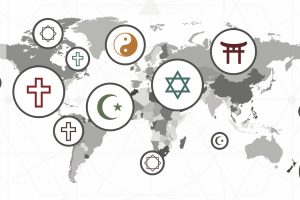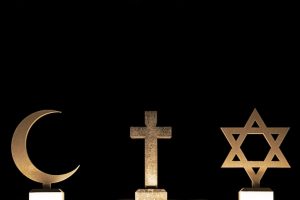
Location: Cordoba, Spain
Belief: Islam, Christianity
Date: 711 CE
Capacity: 11,000
The modern Cathedral of Cordoba (Cathedral of Our Lady of the Assumption) in southern Spain has a shared history between Christianity and Islam. Originally, the Visigoths (gothic tribe that converted from Paganism to Christianity) of early Spain built a Catholic Basilica here. When the Muslims landed in Spain in 711 and reached Cordoba, the site was divided and used by Christians and Muslims at the same time. This arrangement was in place until 784 when it was purchased by the Muslims under Abd al-Rahman I (founder of the Muslim dynasty that ruled greater part of Iberia for nearly 300 years) and rebuilt as a purpose built mosque initially with a capacity of 10,600. [1] The Christians were able to rebuild their churches nearby with the funds.
Through the history of Muslim Al-Andalus, the mosque was a cultural and religious centre, and was repeatedly extended and improved over several hundred years at a time when the local Muslim population was over a million. [2] The key extensions were completed under his successors, namely Abd al-Rahman II from 833-852 CE, then Al-Hakam II from 961-966 CE and finally under Almanzor around 987 CE. There were four fountains for ablution before prayers, a custom considered foreign by the local Christians, and hundreds of lanterns lit the mosque and surrounding streets at night. [3]
The structure is famous for the 856 distinctive columns and horseshoe arches in the prayer hall in two colours made of brick and limestone. The minaret also became a template for other great mosques in Morocco and Spain.
When the Christians reclaimed Cordoba in 1236, the structure became a church again, and a cathedral nave was constructed in the centre of the structure towards the end of the 16th century, much to the disgust of King Carlos I, who commented:
‘You have built here what you might have built anywhere; to do so, you have destroyed what was unique in the world.’
The Third Khalifah of the Ahmadiyya Muslim Community, Hazrat Mirza Nasir Ahmadrh, visited the site in October 1980 when laying the foundation stone for the new mosque in Pedro Abad, the first new mosque in Spain for 500 years.
Endnotes
[1] Manuel Salcines, The Mosque of Cordoba (Spain: Ediciones Noria, 1990), 8.
[2] Manuel Salcines, The Mosque of Cordoba (Spain: Ediciones Noria, 1990), 4.
[3] Stanley Lane-Poole, The Moors in Spain (UK: Darf Publishers, 1984), 135-139.
Other sources
Richard Fletcher, Moorish Spain (United Kingdom: Orion Books, 1994).




Add Comment